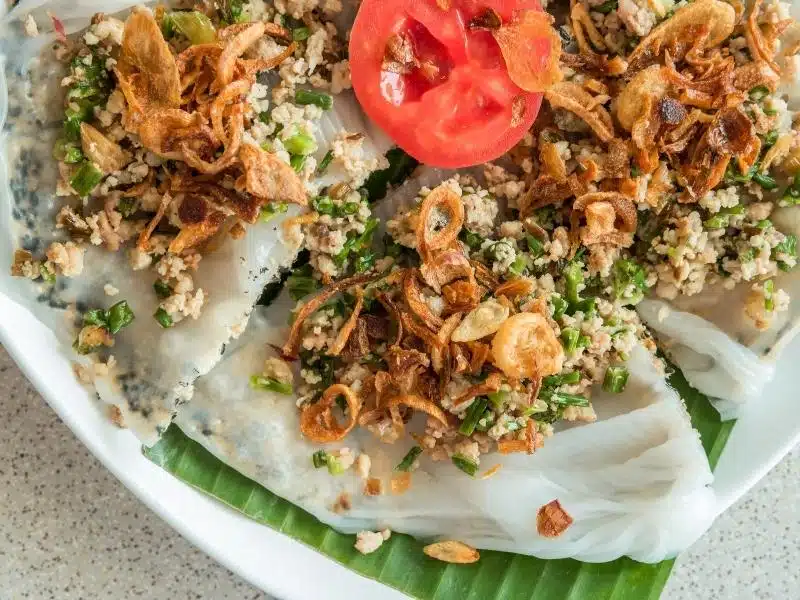Vietnam is truly a foodie’s paradise. Vietnamese foods are known for their balance of flavors and wide variety of colors and textures in a single dish. These traits are even true of Vietnam’s snacks – each bite is truly an experience of its own – reason enough to consider moving to Vietnam!
In this article, we’ll travel across the country, starting with Chinese-inspired Vietnamese street foods in the north, soupy delights in central Vietnam, the addition of coconut in the south, and finally some classic Vietnamese snacks that you’re likely to find all over the country.
In each section, I’ll start with savory snacks, then move into the sweets. These snacks will range from miniature meals to chewy desserts that you can take home with you. And I’m truly sorry if this article makes you drool! Make sure to pack some looser clothes for all that eating you’ll do in Vietnam!
Northern Vietnam Snacks
In the north of Vietnam, where the capital city Hanoi is located, you can expect to find a lot of Chinese influence in the wide array of snacks on offer. This make sense, not just geographically, but also because this part of Vietnam was once rules by China for 1000 years!
Steamed Rice Rolls (Bánh Cuốn)
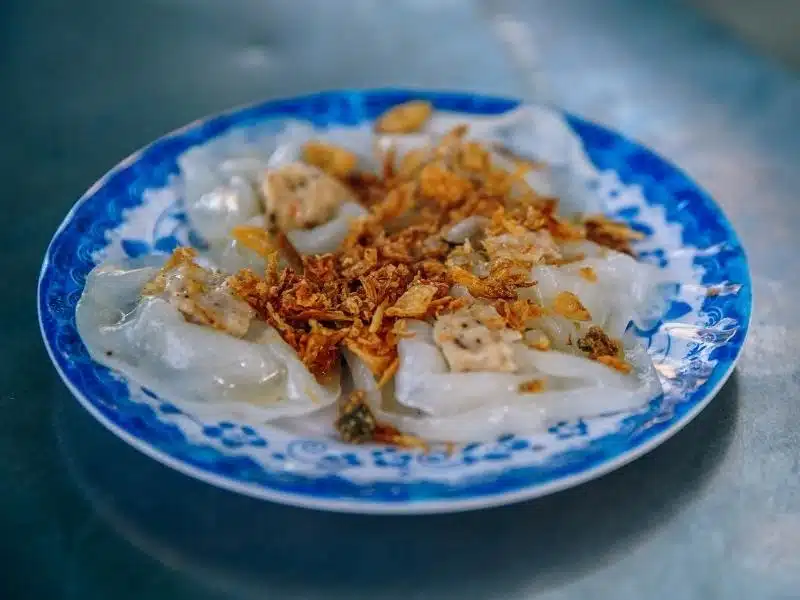
If you’re looking for a refreshing snack to enjoy in Hanoi that combined chewiness and crunch, go for Banh Cuon. This crepe-like treat is made from a sheet of fermented rice batter wrapped around goodies like pork, fried wood ear mushrooms, and minced shallots.
More than just a roll, though, the dish is often served with crisp sides like fresh cucumber slices, bean sprouts, nuoc cham (a fish-sauce-based dipping sauce), and perhaps topped with fried shallots. The dish is often eaten for breakfast. Different areas of Hanoi even have their own variety, such as bánh cuốn Thanh Trì in Thanh Trì district.
If you’ve noticed the word banh here, as in banh mi (Vietnam’s famous baguette sandwiches), it’s because banh is used to refer to a wide variety of cakes, breads, pastries, or other prepared foods eaten with your hands or chopsticks. Thus, you’ll be seeing it again and again in the names below!
Northern Style Pho (Phở Miền Bắc)
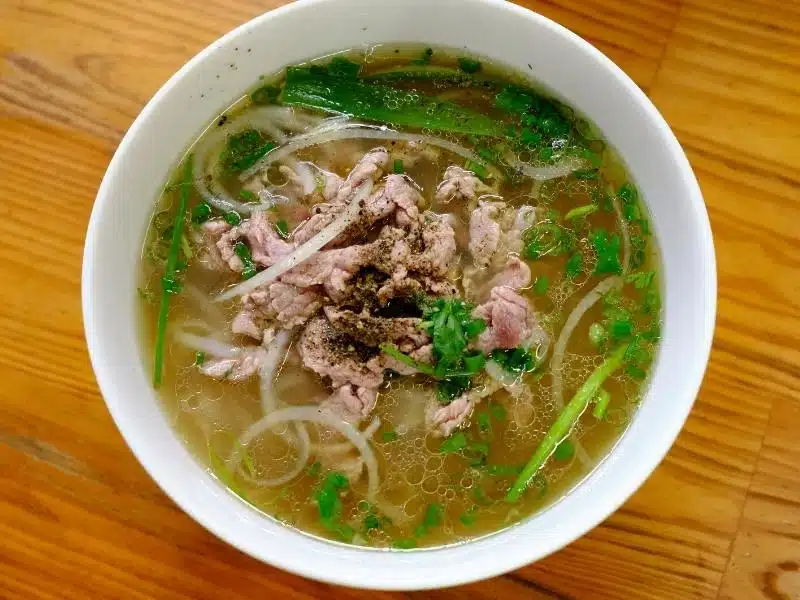
We can’t make a list of Vietnamese snacks without mentioning the country’s most famous dish. And sure, this is more a meal than a snack, but we’ll forgive you for snacking on pho at any time of the day (or night) in Vietnam.
The Northern style of pho tends to have a clear and simple broth, wider rice noodles, chicken or rare beef, and only green onions as a garnish. You may see people dunking chao quay (deep fried dough sticks – see next entry) into their pho, an influence from Chinese cuisine.
Deep Fried Dough Stick (Cháo Quẩy)
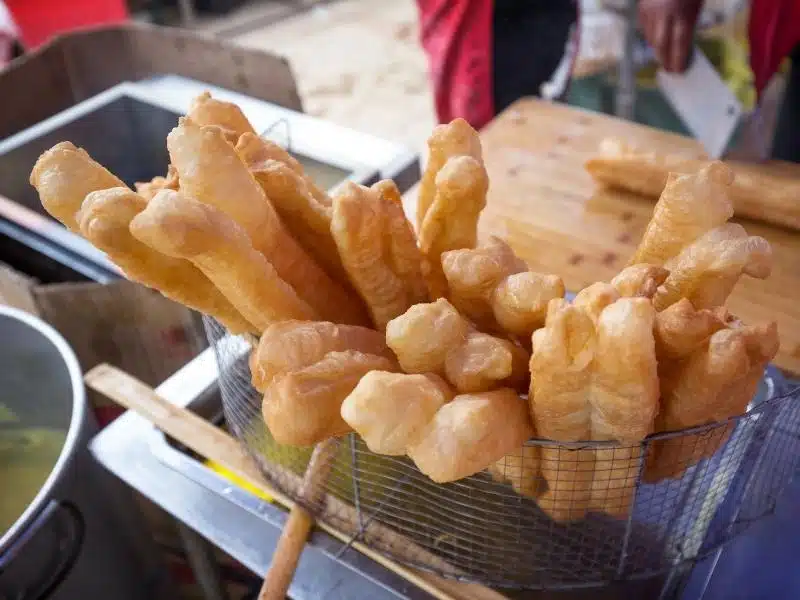
One of numerous snacks to have made its way from Chinese into Vietnamese cuisine is chao quay, or deep fried dough sticks.
In China, what they call youtiao (literally ‘oil sticks’) are usually served with soy milk or congee at breakfast. Vietnamese in Hanoi also enjoy them with congee, but more uniquely they’ll also dip them into pho or wonton soup. Think of it as the Vietnamese version of adding crackers to minestrone soup!
Scorched Rice (Cơm Cháy)
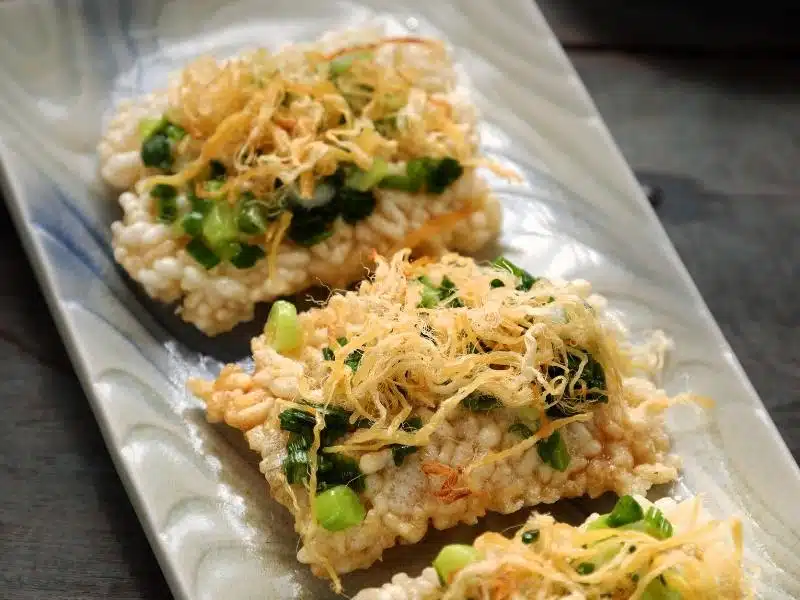
Anyone who has ever cooked rice at home and accidentally burned some at the bottom knows how delicious that crispy, browned rice can be (don’t tell me you haven’t tried it!)
That’s the idea behind com chay, which is often translated as crispy, burned, or scorched rice. But it’s more than just that. In Ninh Binh, Northern Vietnam, they’ve made a dish inspired by it.
Com chay consists of squares or round pieces of cooked and dried rice that have been deep fried to make them crispy. Then they add toppings like goat, beef or pig offal, veggies, pork floss, and spices. This is definitely one of the most unique Vietnamese snacks!
Tofu Pudding (Tào Phớ)
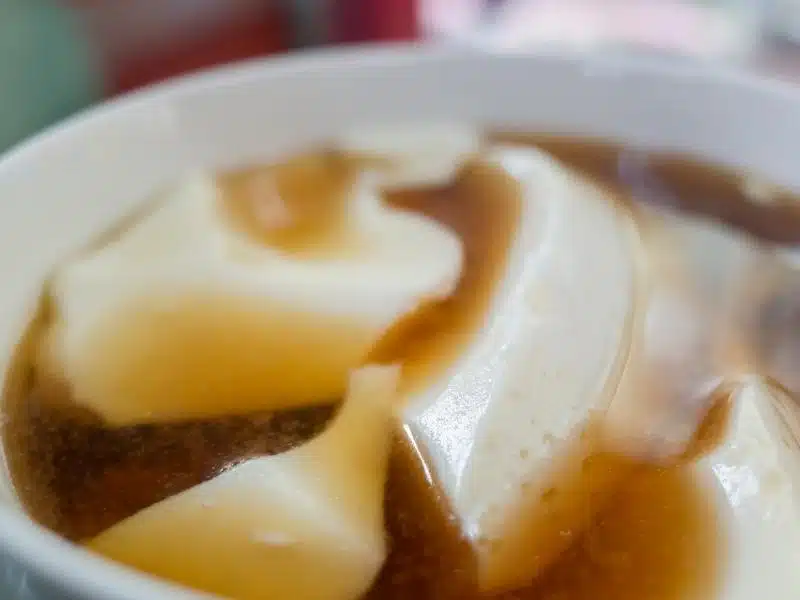
Moving into sweet territory, tofu pudding is another Northern Vietnamese snack of Chinese origin, where it is called douhua (dou meaning doufu or tofu).
Western people might call this dessert tofu, but it’s aso sometimes translated as ‘tofu pudding’. Essentially it consists of sliced hunks of super soft and silky tofu served in a bowl of chilled, sweet broth. It’s unbelievably refreshing on a hot summer day.
Mung Bean Cubes (Bánh Đậu Xanh)

If you’re looking for a packaged Vietnamese snack to take home from northern Vietnam, mung bean cubes are a great choice. Head directly to Hang Duong Street in Hanoi’s Old Quarter, famous for its many cake and sweet shops, to find it – each maker has its own distinct recipe. The Old Quarter is also home to one of the most famous temples in Vietnam.
These bite-sized snacks are made of mung bean powder and sugar compressed into cubes, which fall apart and dissolve in your mouth. They are the perfect accompaniment to hot traditional tea such as green tea or oolong.
Sugared/Salted fruits (Ô Mai)
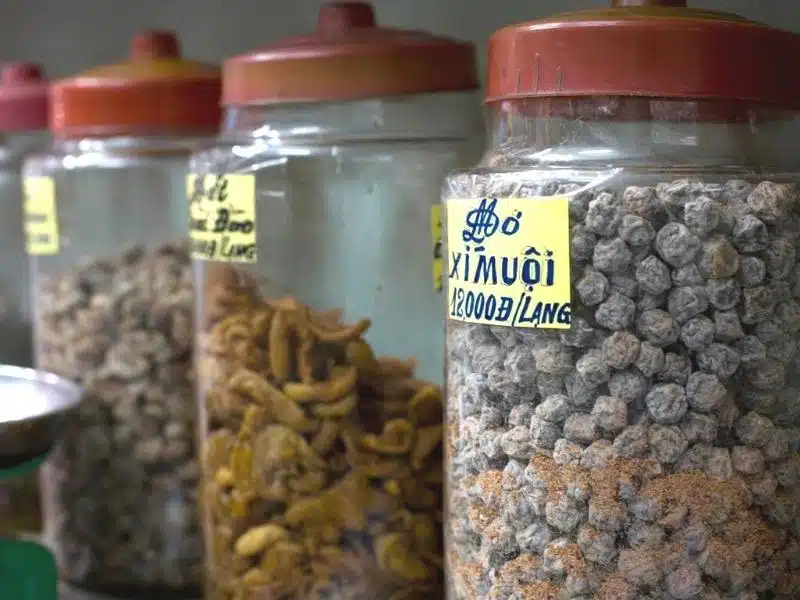
Another Vietnamese snack you can find on Hang Duong Street in Hanoi is o mai, a kind of very traditional sugared fruits. But unlike Western sugared fruits, these may also be prepared with salt, chili, ginger and other spices, and/or lime juice.
Common fruits used include apricot, plum, kumquat, and star fruit, but you may see several others. They are especially popular around Tet, the Vietnamese Lunar New Year, and often enjoyed with lotus tea, a kind of lotus-scented green tea made in Vietnam.
Fried Glutinous Rice Balls (Bánh Rán)
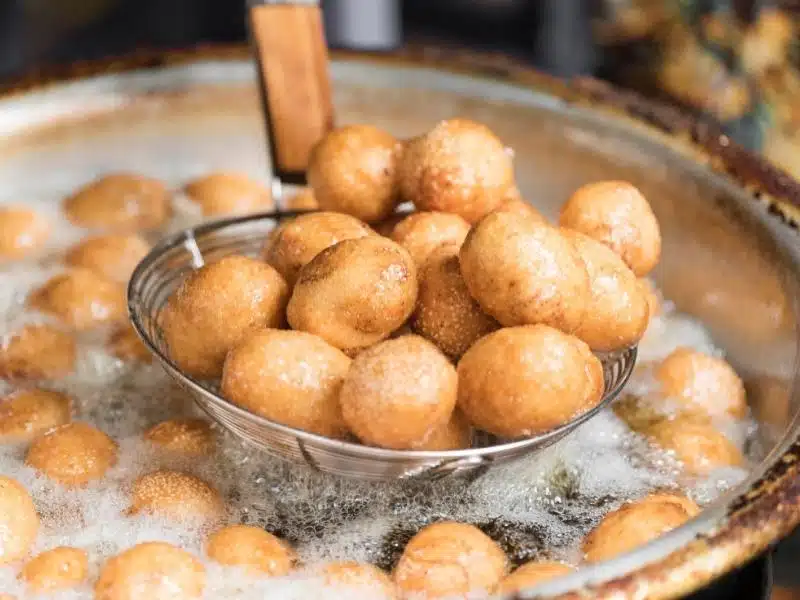
Before leaving the north, there’s one more quintessential Vietnamese snack to be mentioned. Like many other snacks in the north of Vietnam, fried glutinous rice balls (banh ran, or ‘fried banh’).
More specifically these are deep fried glutinous rice balls. Glutinous rice produces that chewy texture beloved in many Asian snacks. At their core, your mouth will discover sweetened mung bean paste, often scented with jasmine (except in the south, where their version, bánh cam, is not).
Another difference is that in the north, these ubiquitous snacks are sometimes doused in a sweet sauce. They balls are often coated with sesame seeds. You know they’re traditionally made when the mung bean core is separate from the outer shell, so that you can hear it rattling around when you shake it.
Central Vietnam Snacks
Many people consider Central Vietnam to be the country’s food capital. The ancient capital, Hue, and romantic tourist hub Hoi An each contribute their own offerings, most of which you’re unlikely to find in Vietnamese restaurants abroad.
Bun Bo Hue (Bún Bò Huế)

Sure, you know pho, and you’ve probably had it many times even before coming to Vietnam. But have you ever heard of or tried bun bo Hue, a noodle soup dish that Hue is known for?
Like pho, bun bo Hue (‘Hue’ is added to denote where it’s from, but when it Hue, they’ll just call it bun bu) is characterized by a balance of spicy, salty, sour, and umami flavors. But what sets it apart is the use of wider, and cylindrical rice noodles. The broth is made from beef, lots of lemongrass, shrimp paste, and sugar.
It comes with various meats that may include beef shank, ox tail, or pig knuckle. Also unlike pho, bun bu Hue is often spicy due to the addition of chili oil. For toppings, you could get lime wedges, onions, mint, basil, coriander, veggie slices, or bean sprouts. Bun bo Hue is a flavor bomb, so don’t miss it!
Hue Clam Rice (Cơm Hến)
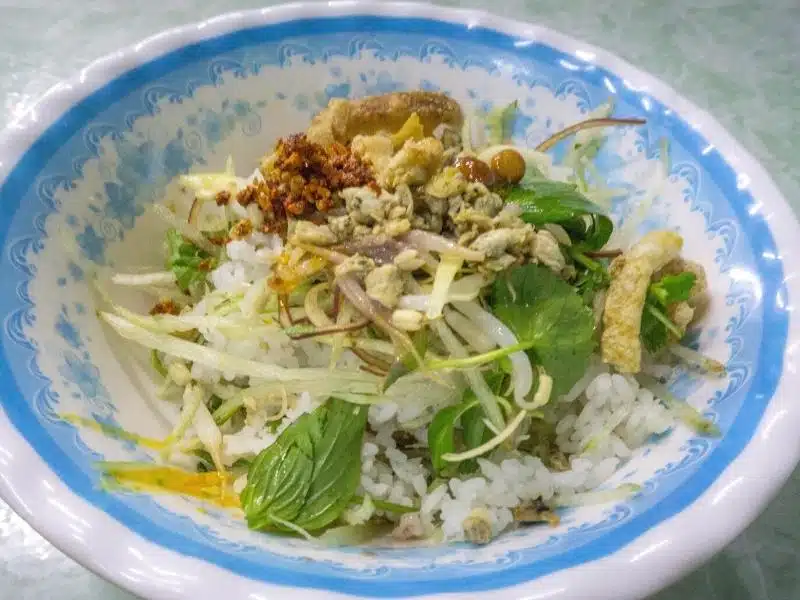
Another Hue staple snack that every visiting foodie is recommended to try in Hue is clam rice. You could consider this a small, light meal, or a big, savory snack to be enjoyed at any time of the day.
This hodgepodge of ingredients, usually including rice, clam meat, fried pork skin, chili, basil, roasted peanuts, garlic, and more is usually served in a small bowl. It is highly flavorful, with all kinds of softness and crunch going on. Give it a good stir before eating!
You can also get it with rice noodles instead of rice, which is called Bún Hến.
Cao Lau (Cao Lầu)
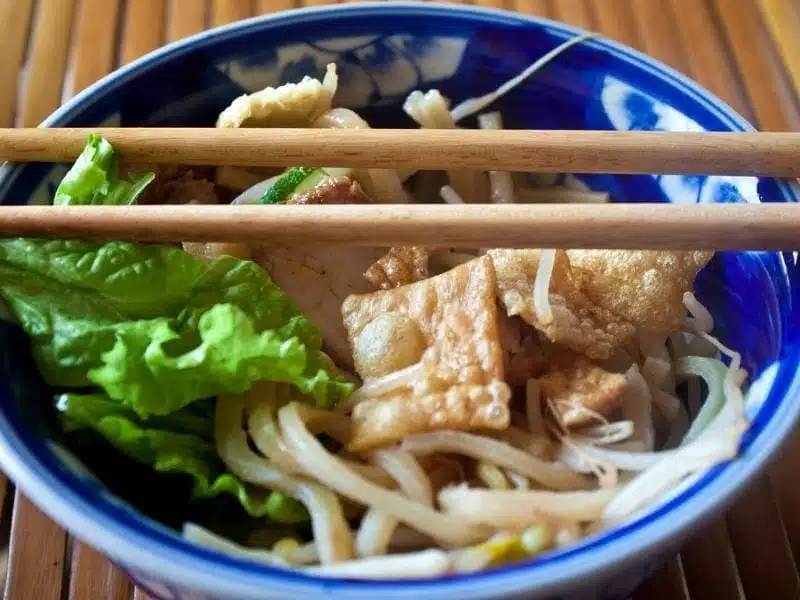
While you can’t miss bun bo and clam rice in Hue, over in Hoi An, it’s all about the cao lau.
Cao lau is unique for its noodles, which are soaked in lye water to give them a special texture and darker color than other noodles in Vietnam. The noodles are served with pork, greens, bean sprouts, herbs, a little brother for flavor (but this is not a soup dish), and sometimes shrimp.
According to Hoi An locals, to make true cao lau, the lye should be made from certain plants on the nearby Cham Islands, while the water has to come from Bá Lễ well in Hoi An.
When we last visited Hoi An, our hotel gave the option of Western breakfast or cao lau to start each day – you know what we went with. We seriously couldn’t get enough of cao lau!
Quang Noodles (Mì Quảng)
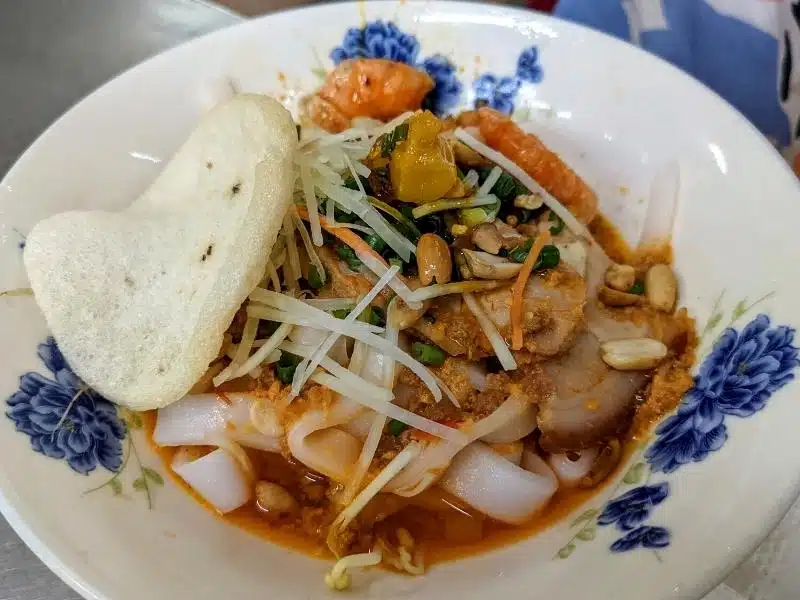
Quang Nam province, where Hoi An is located, also gave birth to another noodle dish that you won’t soon forget: mi Quang.
In this case, expect wide rice noodles, which are sometimes yellow from the addition of turmeric. Like many Vietnamese dishes, they’ll come with various meats, veggies, and herbs, as well as a medium amount of broth. Unusually, it may also come with peanuts, hard boiled egg, and/or toasted rice crackers.
Like cao lau, this is a smaller noodle dish that is more commonly enjoyed for breakfast of maybe lunch.
Flat Steamed Rice Dumpling (Bánh Nậm)
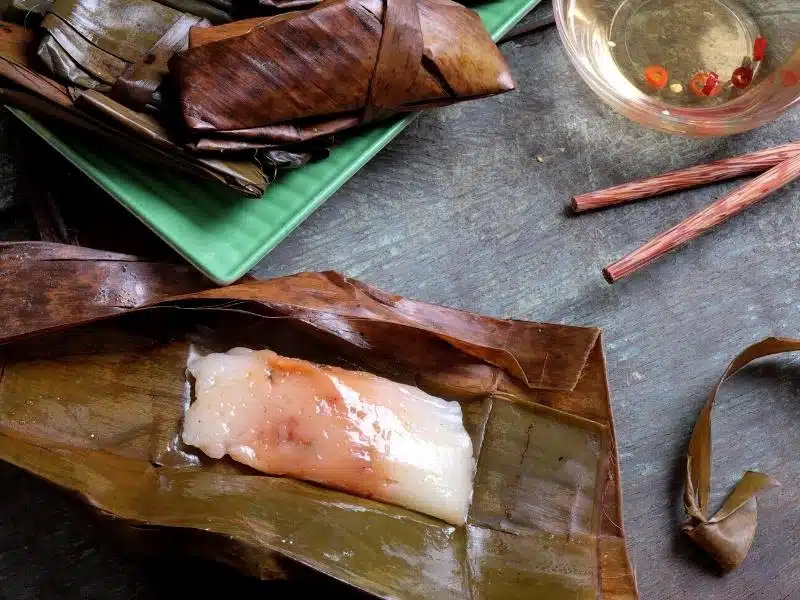
You will often see banh nam referred to as Vietnamese tamales, as they really are quite similar. Both are highly fragrant snacks made from steaming various ingredients in a banana leaf to produce a savory, soft, and warm cake.
Vietnamese ones are made with rice flour rather than corn (although rice flour is sometimes used in Latin America too!) Ingredients stuffed in may include pork, shrimp, mushrooms, and spices. Even better, you may also get nuoc cham (dipping sauce) to douse it in.
Lemongrass pork skewers (Nem Lụi)
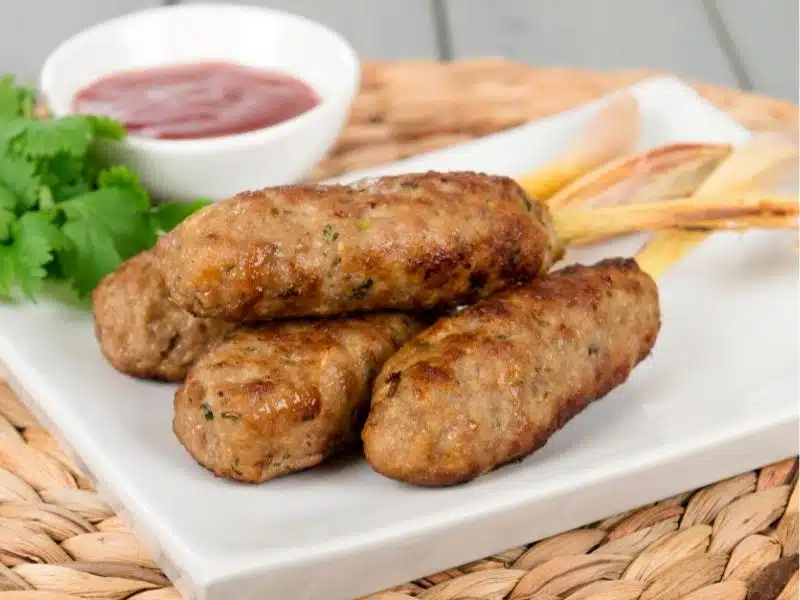
Grilled eat on a stick is a beloved street snack across Asia and other parts of the world. But Hue chefs add a twist by grilling their pork on a stick of lemongrass rather that a regular wooden or metal skewer.
As you can probably imagine, the lemongrass imparts a magical flavor on the meat. As if that weren’t enough, you also usually get a tangy and/or peanut based sauce to dip them into. Watch for stalls serving them in the late afternoon or especially at night, or you may see it on some restaurant menus.
Sugar Cane Shrimp (Chạo Tôm)
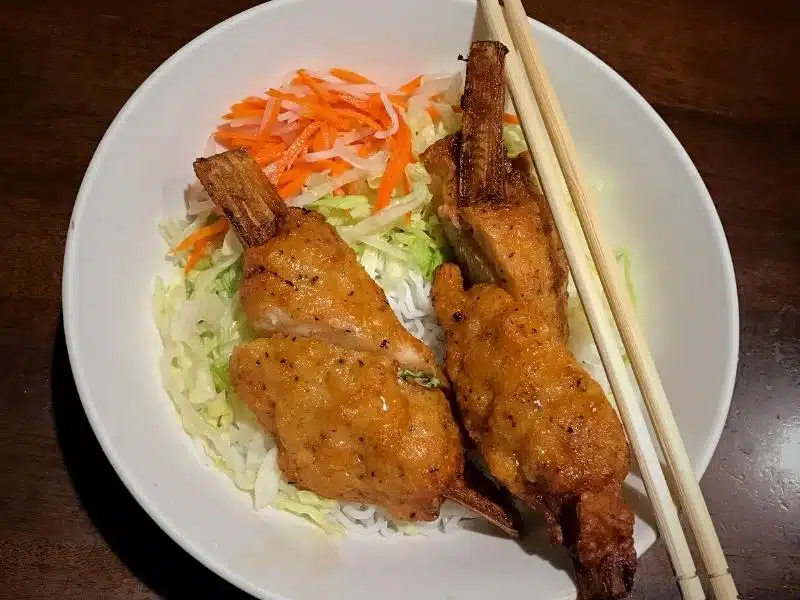
Like nem lui, sugar cane shrimp a cooked on served on a stick of (you guessed it!) sugar cane! Don’t expect a whole shrimp but rather a hunk of shrimp surimi (paste). The result is super fragrant, juicy, and straight-up delicious.
Sugar cane shrimp are often served as a snack or appetizer in restaurants. Fancier versions are often presented at weddings or banquets, served with fresh ingredients such as salad, crushed peanuts, and/or cold rice noodles. You can also find sugar cane shrimp in the frozen section of grocery stores!
Peanut and Rice Paper Brittle (Kẹo Cu Đơ)
Central Vietnam isn’t only about Hue and Hoi An. This popular Vietnamese snack hails from Ha Tinh province in North Central Vietnam.
Think whole peanuts in gooey sauce of sugar cane molasses, malt, sesame and ginger, then sandwiched between two sheets of rice paper. The word keo means candy, while Cu Do was the clever candy maker who came up with the idea of adding the rice paper.
Sesame Candy (Mè Xửng)
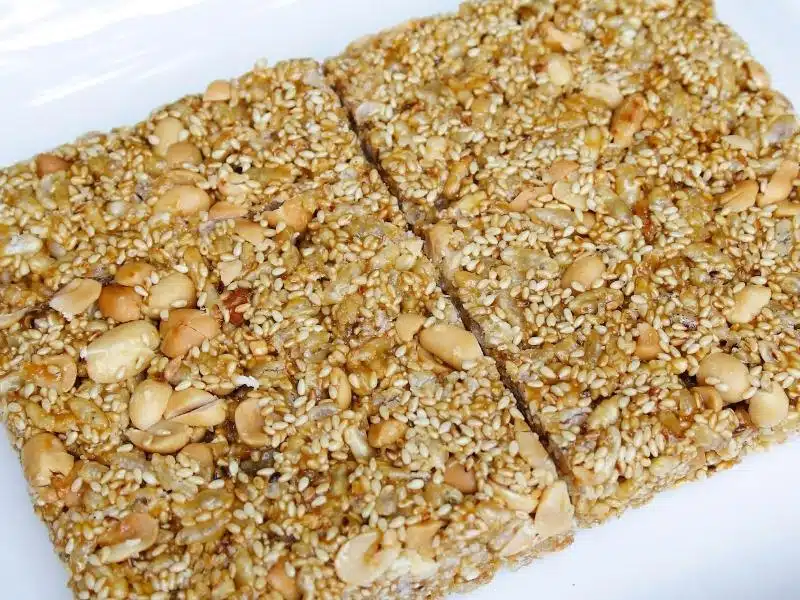
One more central Vietnamese snack to mention is me xung, or sesame candy. These little squares are super chewy, with peanuts in the middle, and an outer surface coated in white sesame seeds.
If you’re looking for a snack from central Vietnam to take home, this may just be it! Residents of Hue, where the candy originated, love to eat it with traditional lotus tea.
Southern Vietnam Snacks
Moving now to the far south of Vietnam, you’ll notice the appearance of coconut in several snacks, as well as greater influence from or similarities to other Southeast Asian cuisines.
Southern Style Pho (Phở Miền Nam)
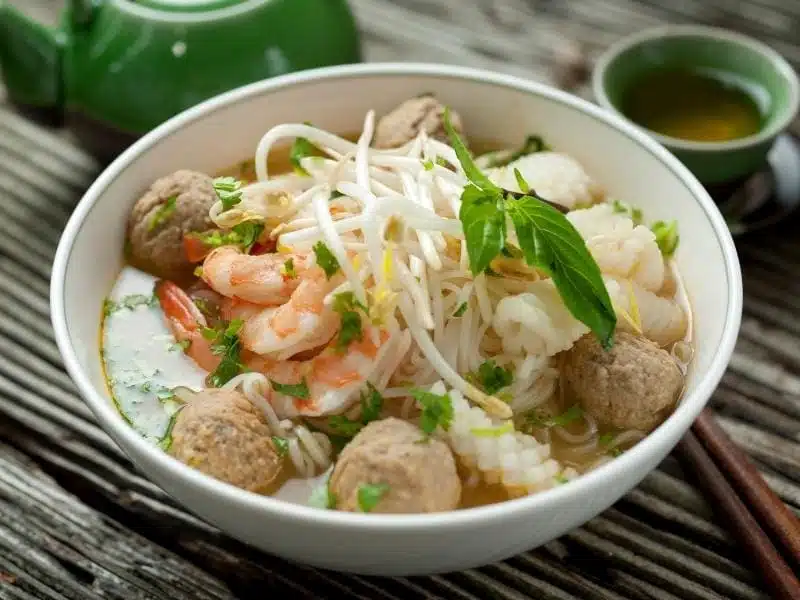
While pho varies widely across the various regions of Vietnam, there are some noticeable general differences between north and south.
In Ho Chi Minh city and other parts of southern Vietnam, you may notice the pho broth is a little sweeter, the noodles a little wider, and there is more meat – which can include beef flank, brisket, tendon, or even meatballs.
Southern style pho also tends to come with a lot of toppings, like bean sprots, lime wedges, basil, and more. This may also be what you are used to seeing in Vietnamese restaurants outside of Vietnam.
Banh Mi (Bánh Mì)
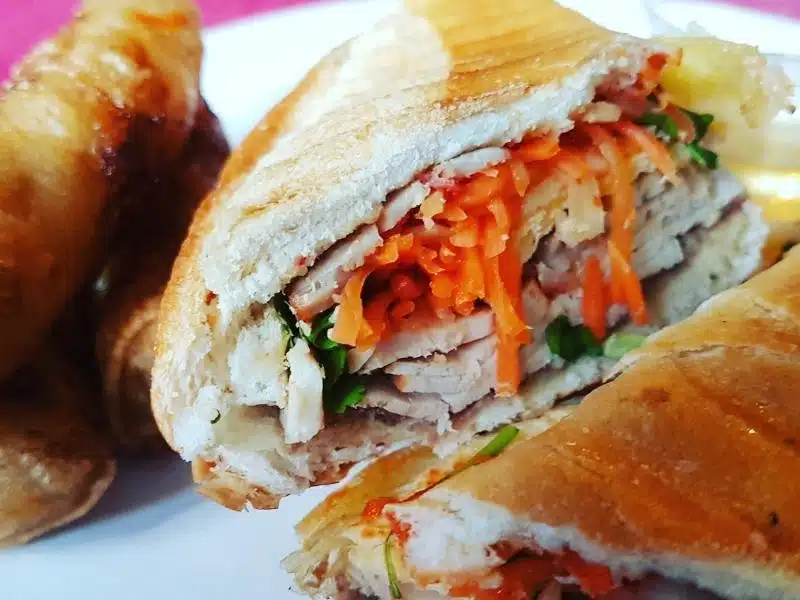
The most various Vietnamese food after pho is without a doubt bahn mi. If you don’t know the story, you can probably guess it: The French brought their baguettes to Vietnam, and locals in Saigon added their own ingredients (you can read the full history of banh mi here).
Taking over the world in recent years, bahn mi are mouth-watering sandwiches with ingredients like meat and pate slices, mayonnaise, cilantro, pickled carrots, and more. This quintessential Vietnamese food is perfect at any time of the day.
Deep Fried Spring Rolls (Chả Giò)
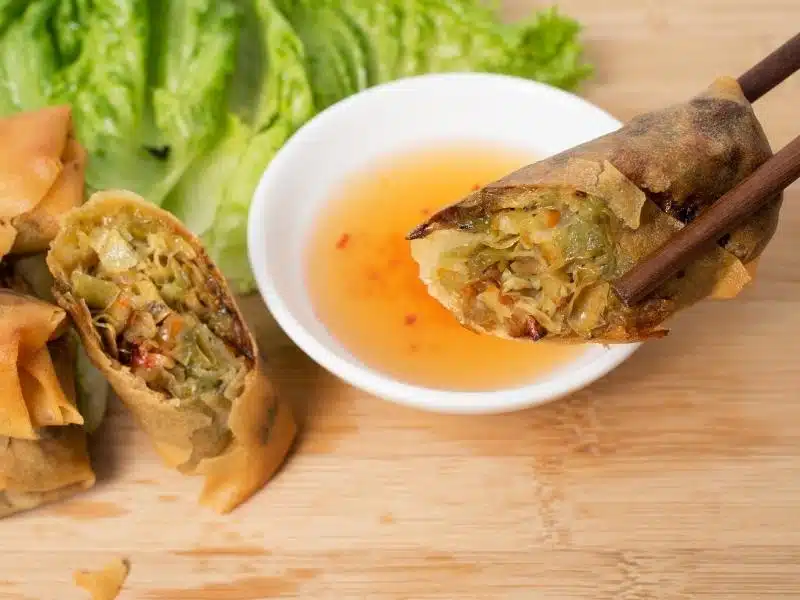
While Vietnamese spring rolls (see final section below) are a quintessential item both inside and out Vietnam, so too are the deep fried version, which is more similar to a Chinese spring roll. However, Vietnamese versions are often made with rice rather than flour-based wrappers.
Vietnamese deep fried spring rolls can come with various ingredients, such as port, shrimp, or vegetarian versions. They may be served as an appetizer, as in most Asian restaurants around the world, or served atop a noodle salad or other fish.
Also watch for nem rán, or egg rolls!
Grilled Rice Paper (Bánh Tráng Nướng)
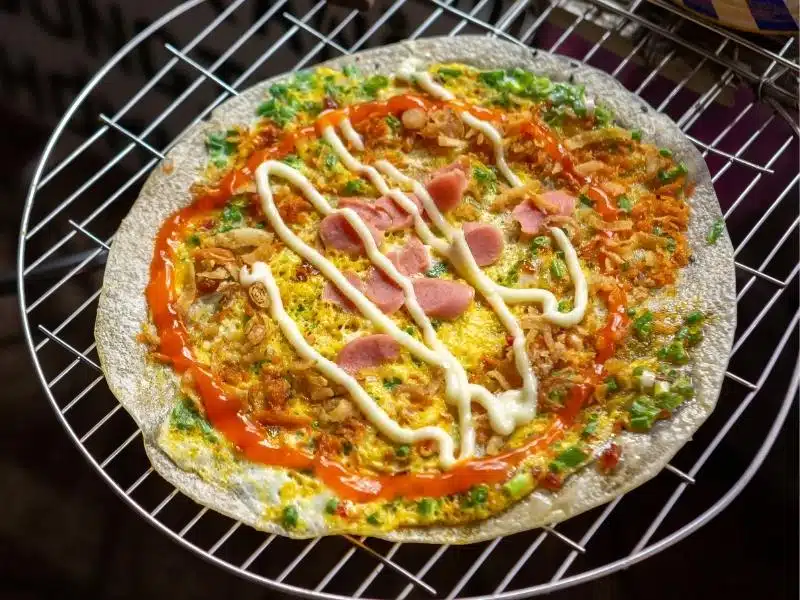
We’ve already covered Vietanamese tamales, so now it’s time for “Vietnamese pizza”!
Grilled rice paper originated in Dalat in the southern Vietnamese highlands, and it is as delicious and as it sounds. As you might guess, it’s made of a sheet of rice paper grilled and with various toppings. These often include egg, meat, and various other toppings.
Because it is fun to eat, this dish is especially popular among youths, who grab it is a light snack from vendors who cleverly park outside of their schools. All see our post covering the best restaurants in Dalat!
Fried Rice Flour Cakes (Bánh bột chiên)
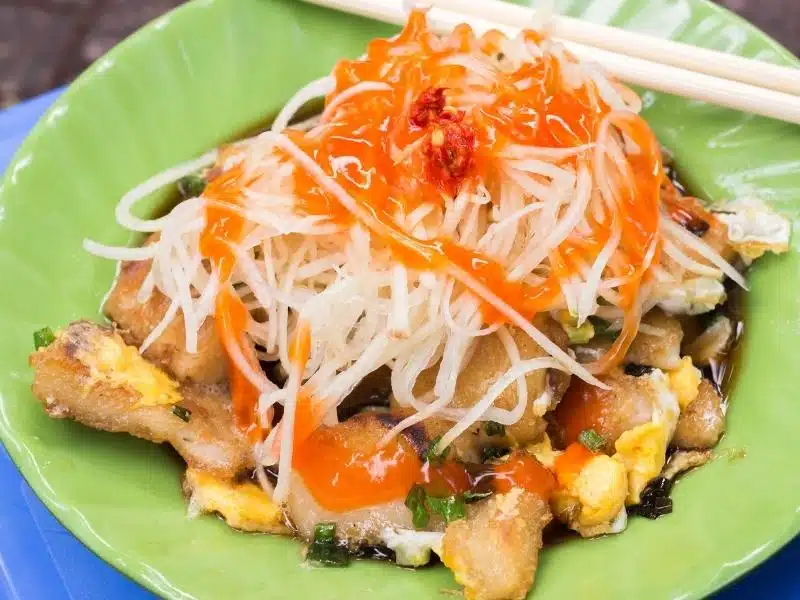
Another popular after-school snack in southern Vietnam is bahn bot chien, or fried rice flour cakes. Some people even call this the Vietnamese version of hash browns.
The rectangular “cakes” in this dish are made from steaming rice flour and tapioca starch into a firm cake, then cutting it into pieces. Next, they are pan fried with eggs and often served topped with pickled carrots and radish.
Give it a taste and you’ll understand why so many Vietnamese kids grow up on this snack!
Prawn Crackers (Bánh Phồng Tôm)
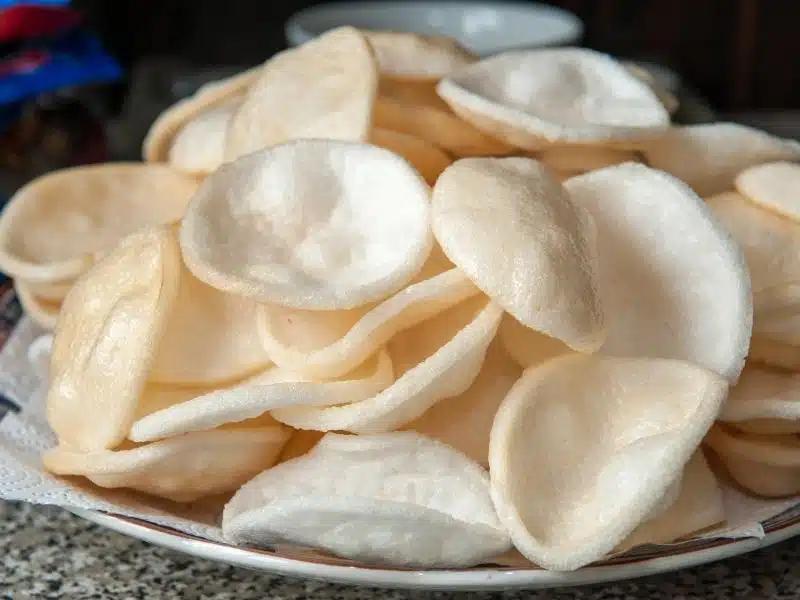
You may already be familiar with prawn crackers, as they are commonly served with dishes in Malaysia, Indonesia, and other parts of Southeast Asia.
The Vietnamese version is called bahn Phong Tom and is most associated with Sa Dec in the Mekong Delta of far southern Vietnam. You can enjoy this as a topping on your meal (they absorb soups nicely) or simply as a snack on their own.
Savory Mini Pancakes (Bánh Khọt)
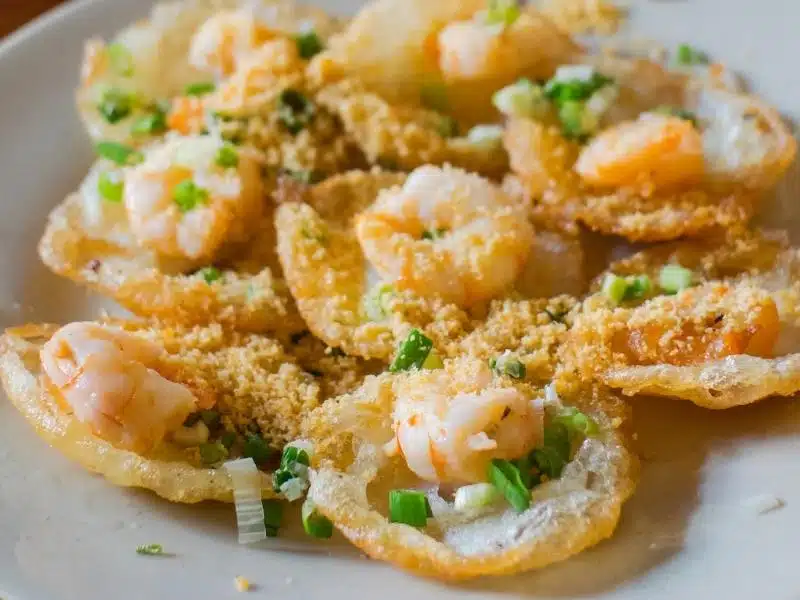
They might be translated as ‘pancakes’, but Banh Khot are nothing like the American ones. These are a savory (salty) snack made from rice flour and coconut milk, made yellow from the addition of turmeric.
Each bite-sized pancake usually has a single whole prawn in it, and nuoc cham sauce for dipping is a must. These are classic southern Vietnamese street snack, but you can also find them in restaurants.
Grilled Pork Sausages (Nem Nướng)

While we’ve already covered lemongrass grilled meat in central Vietnam, southern Vietnam has its own version, called Nem Nuong.
These grilled sausages originated in Khanh Hoa province, where the famous coastal city Nha Trang is located. Their unique flavor comes from the addition of garlic, shallots, sugar, black pepper, and a wee bit of fish sauce.
Coconut Candy (Kẹo Dừa)

Bến Tre province in the Mekong Delta is famous for its coconuts, which are said to be especially sweet. The area is even nicknamed the “Land of the Coconut” (Xứ Dừa). These coconuts are thus perfect for making keo dua, or coconut candy.
These candies come in various shapes, sizes, and textures, from little firm candies to soft and thick cakes. They may be mixed with peanuts, durian, pandan, or other ingredients. These make for the perfect souvenir to take home from your trip, available even in supermarkets, but if you can, try to get the real thing from Ben Tre province.
Artisanal Chocolate

Not all Vietnamese snacks are super traditional. Take artisanal chocolate for example. Vietnam is suitable for growing cacao, and in recent years there has been a rapid growth in artisanal chocolate brands. One of the most well-known examples is Marou.
Founded in 2011, this was the first bean-to-bar chocolate made in Vietnam and remains its most sought-after.
The Ho Chi Minh-based (but expat-run) company only uses Vietnam-grown cacao sourced from six different provinces of Vietnam. This is the perfect Vietnamese snack to take home for chocolate lovers. But don’t limit yourself to Marou, as there are several other reputable makers in Vietnam.
Snacks found Across Vietnam
Many classic Vietnamese snacks are not limited to one region of Vietnam, or their origins are unclear. The following snacks can seen and enjoyed far and wide in Vietnam, from north to south.
Summer Rolls (Gỏi cuốn)
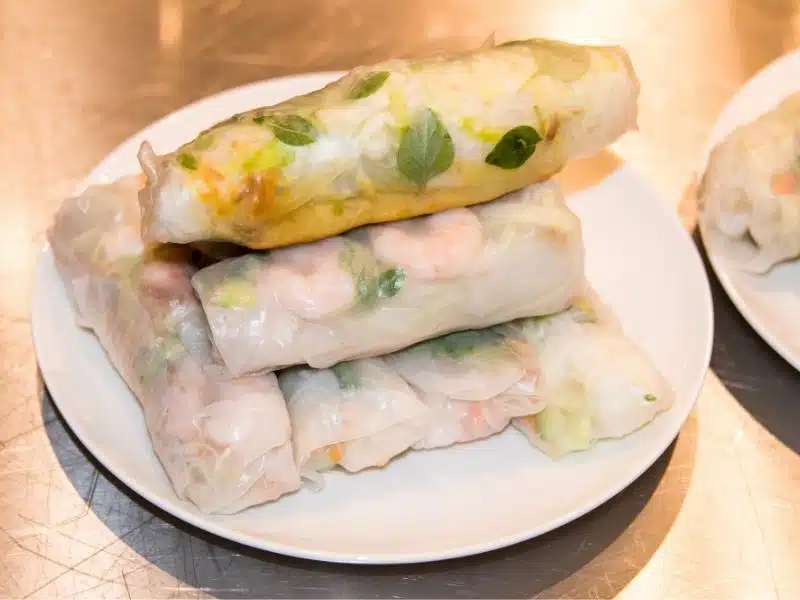
Right up there with pho and banh mi, goi cuon and one of the most famous Vietnamese dishes, and you’ve probably had them before (if you haven’t, it’s high time for you to change that).
These are fresh, cold rolls (hence the name “summer” or “salad” roll), made from wrapping a rice paper, which has been wet briefly to make it soft, around rice vermicelli, lettuce, shrimp, cucumber slices, and fresh mint or other fresh herbs, all meant to be dunked in nuoc cham or peanut sauce. This is the classic Vietnamese appetizer.
Vietnamese Crepes (Bánh Xèo)

We’ve already covered Vietnamese pancakes, hash browns, pizza, and tamales. So how about Vietnamese crepes? (We may soon run out of English words to compare Vietnamese foods to…)
Due to their yellow color, from the turmeric added to the rice flour, they almost look like an omelet or tortilla. But these are more like thin crepes, and their name ‘xeo’ comes from the sizzling sound they make while frying.
Inside, you’ll find various stuffings, like pork, prawn, bean sprouts, and fresh herbs, all served, or course, with nuoc cham sauce. You’ll see these across Vietnam, and there are even vegetarian versions.
Green Papaya Salad (Gỏi Đu Đủ)

Goi Du Du is Vietnam’s answer to the more famous Thai raw papaya or mango salad. Like the latter, it is the perfect way to start a meal, especially in summer.
The dish is similar, except that along with the usual julienned raw papaya, shrimp, fishy sour sauce, and crushed peanuts, the Vietnamese version also often comes with a kind of Vietnamese beef jerky, which has a hint of spice to it, and fresh Asian basil or Vietnamese coriander.
Banana Blossom Salad (Nộm hoa chuối)
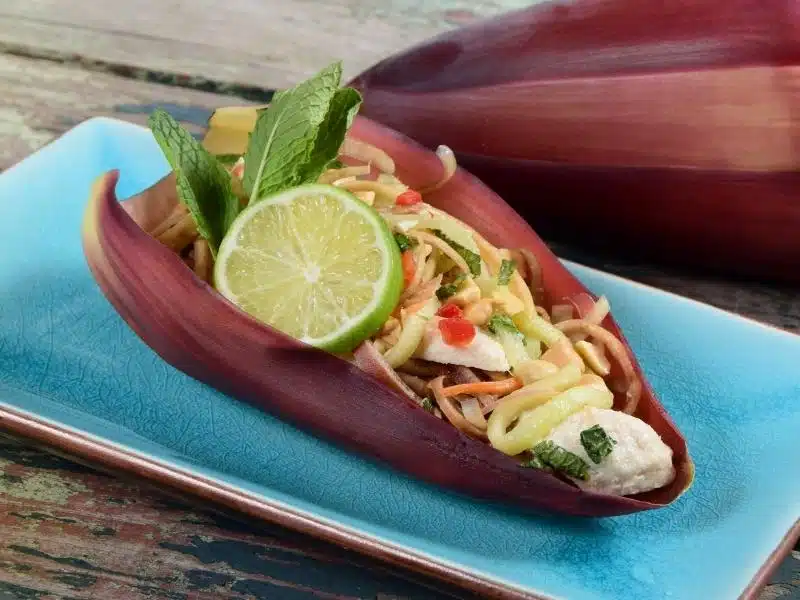
Another Vietnamese salad worth mentioning is nom hoa chuoi (it’s name in the north), also known as goi hoa chuoi in the south.
This exotic dish makes use of the crunchy, fragrant, off-white interior of banana blossoms, after the outer layers have been peeled off. These are julienned and then combined with ingredients such as chicken, pig ear, star fruit, lime, vinegar, lemongrass, chili, mint, and cilantro for the ultimate exotic, salad.
Dessert Drink (Chè)

Che is a generic word for a wide variety of sweet desserts/drinks/soups (yes, the boundary between those three items is often blurred) in Vietnam.
Like many similar desserts across Asia, these may come with ingredients such as beans, tapioca, jelly, pudding, and fruits like logan, mango, durian, or jackfruit. They can be hot or cold, often depending on the season, or whatever you are the mood for. In the south of Vietnam, a layer of coconut creme is often on top.
There are numerous types of che across Vietnam. Watch for the popular chè ba màu, a tri-color (green, yellow, and red) version, and chè bà ba, which comes with tubers like taro, cassava, and/or sweet potato – we like this one hot.
Candied fruits (Mứt)

Dried/candied fruits are a very popular snack across Vietnam, especially during the Tet (Lunar New Year). It is often placed on the living room table for guests to enjoy with their tea.
Besides the usual fruits you might expect to see, there are more unusual ones like ginger (mứt gừng), carrot, rose petals, peach blossoms, pumpkin, and more.
Steamed Buns (Bánh bao)
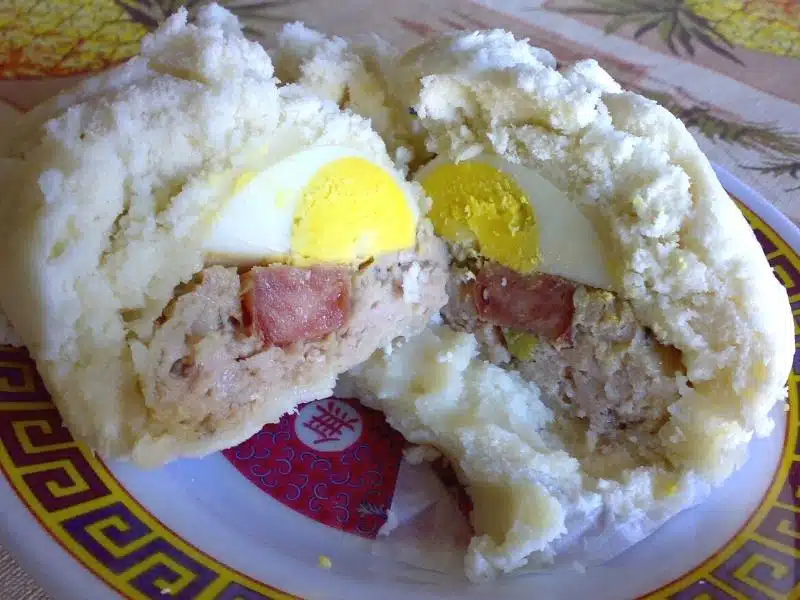
Banh bao are Vietnam’s version of Chinese baozi (steamed buns). Bit into one of these soft, warm buns and you may uncover quail egg, pork, chicken, mushrooms, or, unlike their Chinese counterparts, a chunk of sausage.
Because they were introduced from China, you can expect to see them more in the north of Vietnam, but they can now be found across the country.
Moon Cakes (Bánh Trung Thu)

Like banh bao, moon cakes were introduced to Vietnam by the Chinese. In Vietnam, they are called Banh Trung Thu.
There isn’t really any difference between Chinese or Vietnamese moon cakes. These round or square-shaped cakes are highly filling – you can tell by their sheer weight relative to size. Inside is a thick layer of sweet but very dense filling made from glutinous rice flour, beans, or nuts. There can also be savory ingredients mixed in, such as salted duck egg yolk, pork floss, or other meats.
Moon cakes are said to be high in fat – but weirdly addictive – so some locals avoid them. Still, if you’re living or working in Vietnam, don’t be surprised if you receive one or several boxes of them during the Mid-Autumn Festival, also known as the Moon Festival.
Omni Instant Noodles

Vietnamese are big consumers of instant noodles, and there are several brands worth seeking out for your late-night snack. We love the Omni brand of instant noodles, which have a nice texture, flavorful broth, and a nice hint of lime.
This brand is super popular as a between class snack for students in Vietnam. Besides in Vietnam, you can also find it in Asian supermarkets around the world.
Well, that brings us to the end of this list of Vietnamese snacks. Hopefully you’ll be able to eat your way through the list in your next trip to Vietnam!
